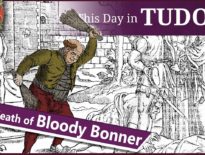On this day in Tudor history, 6th September 1520, the famous reformer Martin Luther sent his pamphlet “On the Freedom of a Christian” (also known as “A Treatise on Christian Liberty”) to Pope Leo X. In the pamphlet, he emphasised the “two-fold nature” of Christians as saints and sinners, flesh and spirit.
Luther is, of course, seen as the catalyst of the European Reformation, and in today's talk, I explain why, what he believed, how he ended up being excommunicated and made an outlaw, and what happened to him.
Also on this day in Tudor history, 6th September 1615, in the reign of King James I, Tudor physician, clergyman and inventor of modern shorthand, Timothy Bright, was buried at St Mary's Church, Shrewsbury. Find out more about this fascinating man and the works he published in Elizabeth I’s reign, which have helped people the world over, in last year’s video:
Also on this day in history:
- 1506 – Death of Sir Richard Guildford, courtier and administrator in the reign of Henry VII, in Jerusalem on pilgrimage. He was buried on Mount Syon. Guildford's offices included Master of the Ordnance and Armoury in the Tower of London, Master of the Horse and Privy Councillor.
- 1572 – Death of Sir Henry Jerningham at his manor of Costessey in Norfolk. He was buried in the parish church there. Jerningham served Henry VIII, Edward VI, Mary I and Elizabeth I, and his offices in Mary's reign included Privy Councillor, Vice-Chamberlain of the Household, and Captain of the Yeomen of the Guard.
- 1578 – Sir Francis Drake and his ship, the Golden Hind (or Pelican as it was called then), entered the Pacific Ocean on its circumnavigation of the globe.
Transcript:
On this day in Tudor history, 6th September 1520, the famous reformer Martin Luther sent his pamphlet “On the Freedom of a Christian” (also known as “A Treatise on Christian Liberty”) to Pope Leo X. The pamphlet opened with the following dedicatory address to the Pope:
“AMONG those monstrous evils of this age with which I have now for three years been waging war, I am sometimes compelled to look to you and to call you to mind, most blessed father Leo. In truth, since you alone are everywhere considered as being the cause of my engaging in war, I cannot at any time fail to remember you; and although I have been compelled by the causeless raging of your impious flatterers against me to appeal from your seat to a future council—fearless of the futile decrees of your predecessors Pius and Julius, who in their foolish tyranny prohibited such an action—yet I have never been so alienated in feeling from your Blessedness as not to have sought with all my might, in diligent prayer and crying to God, all the best gifts for you and for your see. But those who have hitherto endeavoured to terrify me with the majesty of your name and authority, I have begun quite to despise and triumph over. One thing I see remaining which I cannot despise, and this has been the reason of my writing anew to your Blessedness: namely, that I find that blame is cast on me, and that it is imputed to me as a great offence, that in my rashness I am judged to have spared not even your person.”
In his pamphlet, Luther emphasised the “two-fold nature” of Christians as saints and sinners, flesh and spirit. He examined the paradox of a Christian's life - his freedom, due to God's forgiveness, but also his duty to serve God and his neighbours; and his sinful nature which caused him to be deserving of death, but his freedom of sin and his redemption because of his rebirth in faith. Luther believed that a Christian became free from the bondage of sin by faith rather than good works. This was his doctrine of justification by faith alone through the grace of God.
Martin Luther is viewed as the main catalyst of the European Reformation because his written works were circulated widely around Europe and had a major impact. He had come to prominence after he sent out his The Ninety-Five Theses (proper title: “Disputation of Martin Luther on the Power and Efficacy of Indulgences) in October 1517. In his theses, among other things, he attacked the sale of indulgences, emphasised justification by faith, explained the limiting power of the Pope, emphasised that true repentance should be a way of life and not earned by confession, and declared that it was blasphemous to consider the cross with papal arms on it as of equal worth of Christ's cross.
Luther ended up being excommunicated by Pope Leo X in January 1521 after he refused to retract his 95 Theses. On 12th May 1521, at St Paul’s in London, Bishop John Fisher and Cardinal Thomas Wolsey proclaimed him a heretic and burnt his works, and then on 25th May 1521, Luther was branded an outlaw and heretic by Emperor Charles V in the Edict of Worms.
Luther managed to escape capture, first residing at Wartburg Castle, where he worked on translating the New Testament from Greek to German, and then returning to Wittenberg, where he worked at the university teaching theology and also founded a church based on his ideas and beliefs. He married a former nun, Katharina von Bora and they had six children together.
Martin Luther died on 18th February 1546 and was buried in the Castle church at Wittenberg.



This is how not to make the Church listen. Good polemic, not very good complaint writing.